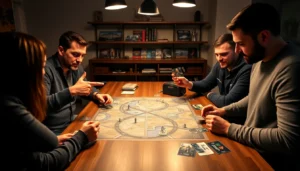Table of Contents
ToggleIn the realm of gaming, few genres evoke as much thrill and excitement as horror RPGs. Picture this: a dark, eerie forest, the sound of distant howls, and your heart racing as you navigate through a world filled with spine-chilling monsters. These games don’t just test your strategic skills; they challenge your very sanity.
Overview of Horror RPG Games
Horror RPG games immerse players in dark narratives filled with psychological tension. These games often feature rich storylines where decision-making affects outcomes, heightening the sense of dread. Players encounter intricate environments designed to evoke fear, such as abandoned buildings, haunted forests, or unsettling towns.
Characters in horror RPGs confront both external threats and internal fears. Monsters, ghosts, or supernatural entities serve as adversaries, each with unique abilities that challenge players’ survival instincts. Complex character development allows for personal growth, creating emotional investment in the narrative.
Mechanics play a crucial role in immersion. Turn-based combat introduces strategic elements, requiring players to plan actions carefully. Resource management amplifies tension, as players must collect items such as health packs or ammunition while navigating perilous locations.
Sound design heightens the experience, with ambient noises and eerie music enhancing the atmosphere. Additionally, visual elements contribute significantly, utilizing dark palettes and unsettling graphics to create a sense of unease.
Horror RPGs also explore themes of isolation, trauma, and the unknown. These themes resonate with players, drawing them deeper into the story. Often, moral choices complicate character arcs, prompting reflections on good, evil, and the consequences of actions.
Community engagement features prominently in many horror RPGs. Online forums or social media discussions allow players to share experiences, strategies, and theories about the game’s lore. Alternative endings or secrets encourage replayability, keeping players invested in the horror narrative.
Overall, horror RPGs succeed in delivering memorable, spine-chilling adventures that resonate with diverse audiences. By blending storytelling, gameplay mechanics, and atmospheric design, they create haunting experiences that linger long after the game has ended.
Key Elements of Horror RPGs
Horror RPGs rely heavily on certain key elements that enhance the immersive experience.
Atmosphere and Setting
Atmosphere creates a sense of dread that permeates horror RPGs. Designers craft eerie environments filled with unsettling details. Dimly lit rooms, shadowy forests, and dilapidated buildings evoke fear and tension. Every sound matters, from creaking floorboards to distant whispers, heightening anxiety. Visual elements, like unsettling graphics, contribute to the overall ambiance. Settings often reflect psychological themes, drawing players deeper into the narrative. Players navigate these foreboding spaces, where the environment itself seems to threaten their survival. Each location adds layers to the story, making exploration both thrilling and unnerving.
Character Development
Character development drives personal investment in horror RPGs. Characters undergo profound growth, shaped by experiences and decisions. Players often confront moral dilemmas that influence their arcs and relationships. Directly engaging with character backstories creates emotional depth and connection. Traits can evolve based on choices, resulting in unique outcomes and endings. Players may experience internal conflicts that mirror external threats, enhancing immersion. The journey often reveals vulnerabilities, prompting reflections on individual fears and motivations. As characters face terrifying challenges, their transformations become integral to the overall narrative experience. This dynamic element keeps players emotionally engaged throughout their journey.
Popular Horror RPG Games
Horror RPG games offer a range of thrilling experiences that captivate players through fear and suspense. Several standout titles showcase the unique elements of the genre.
Game 1: Silent Hill 2
Silent Hill 2 stands out with its atmospheric storytelling and psychological horror. Players navigate the fog-laden streets of Silent Hill, confronting both monsters and their own inner demons. The game features a complex narrative that unfolds through player decisions, enhancing emotional engagement. Disturbing visuals and haunting sounds amplify the sense of dread, making exploration both terrifying and memorable. Character development remains a core focus, as protagonist James Sunderland embarks on a journey influenced by grief and guilt.
Game 2: Bloodborne
Bloodborne immerses players in a gothic world filled with nightmarish creatures and dark lore. Set in the city of Yharnam, players face challenges that demand strategic combat and resource management. Unique mechanics, such as the rally system, encourage aggressive play to reclaim lost health after taking damage. Rich lore unfolds through environmental storytelling, drawing players deeper into the narrative. The atmosphere remains palpable, with eerie sound design and visually stunning settings that evoke a constant state of tension.
Game 3: Amnesia: The Dark Descent
Amnesia: The Dark Descent captivates players with its focus on psychological horror and exploration. The first-person perspective enhances immersion, creating a sense of vulnerability. Players must solve puzzles and manage sanity while navigating a foreboding castle filled with horrifying encounters. Light and darkness play significant roles; remaining in the dark increases panic and terror. This game emphasizes atmosphere through environmental storytelling, ensuring every corner holds unsettling surprises that keep players on edge.
The Appeal of Horror RPG Games
Horror RPG games captivate players through their intense and immersive experiences. Players engage in dark narratives that foster psychological tension. They encounter rich storylines where each decision influences outcomes and amplifies fear. The design of intricate environments, such as abandoned buildings and haunted forests, adds to the terror, challenging players with both external threats and internal fears.
Atmosphere and setting significantly enhance this immersive quality. Designers create eerie environments filled with unsettling elements like dim lighting and shadowy figures. Each sound, from creaking floorboards to distant whispers, heightens anxiety levels. Visual details contribute to the ambiance, often reflecting psychological themes that draw players deeper into the narrative.
Character development serves as another pivotal element. Protagonists evolve through experiences shaped by players’ choices. Moral dilemmas faced during gameplay influence character arcs and relationships, fostering emotional depth. These transformations maintain player engagement throughout the harrowing journey.
Game mechanics also contribute to the overall experience, with turn-based combat and resource management intensifying suspense. Sound design and visual effects amplify the atmosphere, creating unease through ambient noises and unsettling imagery. Themes of isolation and trauma resonate with players and complicate character arcs by presenting moral choices that explore concepts of good and evil.
Community is an integral aspect of horror RPGs. Players actively share their experiences and theories online, fostering a sense of connection. The presence of alternative endings often encourages replayability, adding to the allure of these chilling adventures. Popular titles like “Silent Hill 2,” “Bloodborne,” and “Amnesia: The Dark Descent” exemplify the genre’s unique elements, delivering haunting experiences that linger long after gameplay ends.
Horror RPGs stand out as a unique genre that captivates players with their blend of storytelling and immersive gameplay. They challenge players not only to confront external horrors but also to navigate their own psychological landscapes. The intricate environments and rich narratives create a sense of dread that lingers long after the game is over.
As players engage with complex characters and moral dilemmas, they find themselves emotionally invested in the outcomes. The atmosphere crafted by sound design and visuals enhances the experience, making every moment feel intense and impactful. With a dedicated community sharing their experiences and theories, horror RPGs foster a sense of connection among players.
Ultimately, this genre offers unforgettable adventures that resonate deeply, ensuring that each haunting encounter leaves an indelible mark on those brave enough to explore its depths.




